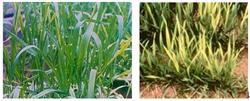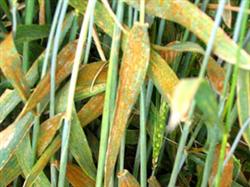Control methods of Wet damage to Wheat

Wet damage of turbid wheat is one of the five pests (wet injury, freezing injury, dry and heat injury, grass damage, diseases and insect pests) in wheat production. In recent years, Hubei, quasi-northern wheat areas, Jiangsu hilly wheat areas and other common, there are different savings occur every year. The root system of wheat damaged by moisture is in the environment of hypoxia for a long time, and the absorption function of the root is weakened, resulting in water deficiency in the plant, and serious dehydration, wilting or death, so the wet damage is also known as physiological drought damage. It can be injured from seedling stage to flowering and filling stage, resulting in mildew and rot of seedlings, low seedling rate, delayed tillering, underdeveloped root system and yellow seedling leaflets; the three functional leaves at jointing and heading stage are 20%, 30% and 36% shorter than those of healthy plants, respectively, and the effective panicle is reduced by 40%; at flowering and filling stage, the damaged functional leaves are prematurely senescent, the number of grains per ear is small, and the 1000-grain weight is reduced, resulting in high temperature, high humidity, early maturity and serious withered death. The wet damage occurred in the middle and later stage of production was heavier than that in the early stage, and the wet damage loss was the heaviest at jointing and booting stage, during which there were fewer effective panicles, fewer grains per panicle, lower grain weight and lower yield. In Huaibei wheat area, although the incidence of wet injury is not very high, the harm can not be ignored. In the past 44 years, wet damage of varying degrees occurred in 13 years in Xuzhou area, accounting for 29.5%. The damage caused by waterlogging increased in the past 10 years, especially in 1989, 1990 and 1991, with heavy rainfall, resulting in wheat lodging in a large area and grain weight decline. mildew and sprouting, causing huge losses to wheat production. After autumn sowing in 1996, the rain lasted for 10 days, and the rainfall reached 104.4mm, which caused most of the wheat in Tongshan County to suffer from wet damage and serious losses. The main cause of wet damage. The rainfall 104mm of nearly 10 days from late October to early November 1996 increased 79.7mm and 90.8mm compared with the same period of normal year and 1997. Too much Rain Water caused excessive water content in plough layer, water saturation in plough layer, lack of oxygen, long-term anoxia of roots, inhibition of respiration, decline of activity, decrease of ability to absorb water and fertilizer, and the production of reducing toxic substances in soil to poison roots under anaerobic conditions. The root system grew poorly and the root quantity decreased. At this time, the nitrogen metabolism in the plant decreased, and the nitrogen content in the functional leaves decreased obviously, resulting in yellow or stiff seedlings. Second, the groundwater level is high, especially when wheat is irrigated in wheat fields or low-lying water near rivers and lakes, the groundwater level is high, and the damage to the root system of wheat seedlings is determined to be only 2.98 secondary roots per plant in wet damaged wheat fields, which is 1.54 less than that of the control. in severe cases, there are almost no secondary roots. Although it could grow slowly in the overwintering stage, the secondary rooting of single plant decreased by 2mur3 at the turning green stage, resulting in fewer leaflets, yellow color, stiff seedlings and fewer tillers and total seedlings per plant. At the jointing stage, there were 5.7tillers per plant, less than 0626 large tillers above three leaves, and the tiller quality was lower, resulting in a lower number of panicles. Third, the three ditches are non-magnetic, the drainage and irrigation facilities are poor, the open water cannot be drained, the dark water cannot be filtered, and the ditch box is not smooth, resulting in wet damage. Fourth, the layout is unreasonable, especially irrigated wheat or paddy field wheat, failed to carry out continuous planting, and some planted flowers in winter irrigated fields, resulting in the wheat field can not be drained out, stagnant water for a long time of disaster, the emergence of serious green and withered seedlings.
- Prev

What is wheat rust like?
What is wheat rust like? Wheat rust is also called jaundice. There are three kinds of stripe rust, leaf rust and stem rust. It is the most widespread and most harmful disease in wheat. After wheat is infected with rust, chlorotic spots appear on the surface of wheat leaves or straw at the initial stage, followed by yellow or reddish-brown pink blisters.
- Next

Comprehensive control methods of wheat take-all disease
Wheat total erosion disease is a typical root disease, which can be infected from sowing to harvest. The main site of the disease was in the root of wheat and the 1-Murray 2 node at the base of the stem. After infection, the roots blackened and rotted, lost the ability to absorb water and nutrients, and caused the aboveground parts to dry up and die, resulting in white ears. One.
Related
- The first cup of black tea in spring, the flavor and history of tea gardens in Kenya, Africa
- The computer can not only choose potatoes, but also grow tea rice. AI will grow winter oolong tea champion.
- It is not only the inflated tea bitten by insects, but also engraved with the four seasons tea in Beipu.
- The Oriental Beauty Tea Festival in Zhuxian County takes the stage at the weekend to experience the plus-size feast of oil tea.
- & quot; Oriental Beauty Tea & Exploration of Emei in Hsinchu, the hometown of quot;
- The new variety of strawberry "Tainong 1" dessert is the first choice with mellow aroma. Crimson gorgeous
- History of Tea in Taiwan: from Wild Inner Mountain to Export Tea Garden
- Two types of Taiwan Oriental Beauty Black Tea won the British three-Star Award for Childhood Tea Xiang Zhang Jiaqi changed from pilot to champion tea maker.
- Banana species and varieties: the planting history of Taiwan Xianren banana and dwarf banana is long, is banana disease resistant?
- Coffee planting Technology: Qianjie Coffee from Seedling to harvesting

